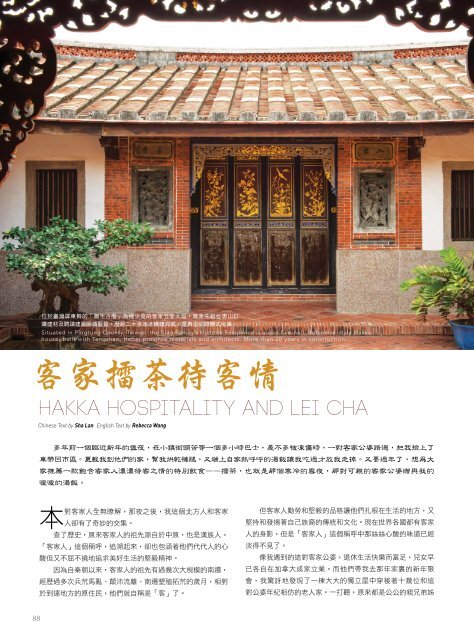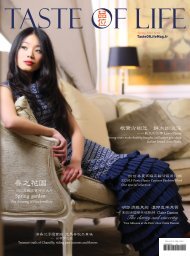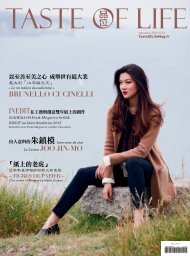You also want an ePaper? Increase the reach of your titles
YUMPU automatically turns print PDFs into web optimized ePapers that Google loves.
位 於 臺 灣 屏 東 縣 的 「 蕭 宅 古 厝 」 為 極 少 見 的 客 家 五 堂 大 屋 , 蕭 家 先 祖 從 唐 山 訂<br />
購 建 材 及 聘 請 建 築 師 傅 監 督 , 歷 經 二 十 多 年 才 構 建 完 成 , 是 典 型 的 防 禦 式 宅 第 。<br />
Situated in Pingtung County, Taiwan, the Siao Family’s Historic Residence is a rare five-hall, defensive-style Hakka<br />
house, built with Tangshan, Hebei province materials and architects. More than 20 years in construction.<br />
客 家 擂 茶 待 客 情<br />
Hakka Hospitality and Lei cha<br />
妹 和 他 們 的 另 一 半 。 相 較 之 下 , 我 是 這 個 聚 會 中 唯 一 的 小 朋<br />
友 , 雖 然 是 初 次 見 面 , 熱 情 的 公 公 婆 婆 們 卻 按 著 他 們 過 年 的<br />
習 俗 都 往 我 手 裏 塞 紅 包 。 我 相 信 人 和 人 之 間 的 緣 份 , 卻 也 被<br />
老 人 家 們 的 熱 情 和 不 設 防 感 動 著 。<br />
本 是 要 教 大 家 做 擂 茶 , 卻 打 開 了 記 憶 的 門 , 囉 嗦 了 些 許<br />
往 事 。 也 好 , 可 以 讓 大 家 在 製 作 擂 茶 的 過 程 中 也 帶 著 客 家 人<br />
那 濃 濃 的 待 客 之 情 。<br />
擂 茶 香 濃 好 喝 、 主 要 成 份 綠 茶 可 抗 氧 化 及 保 護 心 血 管 ,<br />
花 生 、 芝 麻 、 米 仔 等 乾 果 、 五 穀 類 , 磨 成 粉 末 都 可 加 速 人 體<br />
吸 收 。 習 慣 吃 擂 茶 的 客 家 人 中 , 不 難 發 現 許 多 長 命 百 歲 的 人<br />
瑞 。 春 日 滋 養 , 大 魚 大 肉 後 容 易 造 成 體 質 偏 酸 , 膽 固 醇 升<br />
高 , 來 一 碗 香 濃 的 熱 擂 茶 來 調 節 清 理 身 體 吧 !<br />
擂 茶 湯 底<br />
主 料 : 綠 茶 葉 ( 生 )300 克 、 花 生 200 克 ( 炒 熟 ),<br />
黑 、 白 芝 麻 ( 生 ) 各 200 克 , 米 仔 ( 玄 米 )100 克<br />
做 法 : 綠 茶 葉 放 進 擂 缽 磨 成 粉 末 後 , 再 加 入 炒 熟 的 花<br />
生 、 玄 米 及 芝 麻 持 續 研 磨 , 擂 好 後 加 開 水 , 湯 底 就 算 完 成 。<br />
湯 底 可 以 單 獨 享 用 。<br />
鹹 味 擂 茶 泡 飯<br />
配 料 : 九 層 塔 100 克 、 香 菜 30 克 , 鹽 ; 薯 仔 菜 、 芥 蘭 、<br />
大 蒜 、 四 季 豆 、 長 豆 、 芹 菜 、 蝦 米 、 炒 肉 、 豆 乾 、 花 生 、 蘿<br />
蔔 乾 ( 菜 脯 ), 以 上 蔬 菜 可 隨 季 節 性 食 材 變 化 搭 配 , 選 五 ~<br />
七 種 菜 色 搭 配 食 用 。<br />
做 法 : 擂 茶 湯 底 主 料 快 磨 好 時 加 入 九 層 塔 、 香 菜 和 適 量<br />
鹽 , 磨 好 直 接 沖 熱 水 作 成 鹹 味 擂 茶 湯 底 。<br />
食 材 洗 淨 , 將 蔬 菜 、 豆 乾 全 部 切 小 段 或 小 塊 狀 , 熱 油<br />
鍋 , 依 序 爆 香 豆 乾 、 蝦 米 、 蒜 , 蔬 菜 備 用 , 不 要 炒 太 油 。<br />
碗 中 盛 白 飯 或 米 仔 , 鋪 上 炒 好 的 蔬 菜 、 豆 乾 粒 、 蘿 蔔<br />
乾 。 淋 上 剛 沖 泡 的 鹹 味 擂 茶 湯 底 , 擂 茶 泡 飯 就 完 成 了 。<br />
Years ago, on a snowy night shortly before the Chinese<br />
New Year, I waited for a bus more than an hour in a<br />
small town. I was almost frozen when an old Hakka<br />
couple passed by. They took me to their home, let me dry<br />
by their fire and fed me homemade soup. As Chinese New<br />
Year approaches again, make your own “Lei cha” or “pounded<br />
tea,” the soup that amiable pair gifted me on that memorable<br />
night.<br />
The Hakkas’ ancestors originated from the Central Plain in<br />
China (now Shanxi and Henan Provinces), so although they<br />
live many different places in the world, they are Han people.<br />
Trace the origins of “Hakka” (“guest families”) and you<br />
will find the name witnesses the sorrow of generations of<br />
Hakka, as well as their relentless perseverance in pursuit of<br />
better lives.<br />
Hakkas have survived several large-scale migrations, mostly<br />
caused by wars, since the Qin Dynasty (221-207 BC). Despite<br />
many centuries of farming and trailblazing in their new homelands,<br />
the Hakka refer to themselves as “guests.”<br />
The old couple’s Lei cha was aromatic, thick and delicious.<br />
Like all Lei cha, its base was made of green tea leaves which<br />
have antioxidants and offer cardiovascular protection. The<br />
nutrients of green tea and all of Lei cha’s ingredients are<br />
more easily absorbed when ground. In winter, after consuming<br />
a large quantity of meat and fish, it is very easy to end up<br />
with an acidic constitution and an elevated cholesterol level.<br />
Drink a bowl of fragrant hot Lei cha to tonify and clean your<br />
body. There are many Hakka centenarians!<br />
Lei Cha Soup Base<br />
Ingredients: 300g green tea leaves (raw), 200g roasted peanuts,<br />
200g black and 200g white sesame seeds (raw), and<br />
100g roasted (browned) rice.*<br />
Directions: Grind green tea leaves into powder in a mortar<br />
and pestle. Add roasted peanuts, brown rice and sesame<br />
seeds and continue grinding. Add water into ground mixture.<br />
The soup base is now ready and can be served alone as a beverage<br />
by adding hot water.<br />
Savoury Lei Cha Rice Soup<br />
Ingredients: 100g basil, 30g cilantro, some salt; sweet potato<br />
leaves, broccoli, garlic, green beans, Chinese long beans<br />
(long-podded cowpeas), celery stalks, dried peeled shrimp,<br />
sautéd meat, dried tofu, peanuts and dried radish. The mix<br />
of the vegetables can be changed according to the season.<br />
Choose five to seven ingredients.<br />
Chinese Text by Sha Lan English Text by Rebecca Wang<br />
多 年 前 一 個 臨 近 新 年 的 雪 夜 , 在 小 鎮 街 頭 苦 等 一 個 多 小 時 巴 士 , 差 不 多 被 凍 僵 時 , 一 對 客 家 公 婆 路 過 , 把 我 撿 上 了<br />
車 帶 回 市 區 。 更 載 我 到 他 們 的 家 , 幫 我 烘 乾 褲 腿 , 又 端 上 自 家 熱 呼 呼 的 湯 飯 讓 我 吃 過 才 放 我 走 掉 。 又 要 過 年 了 , 想 為 大<br />
家 推 薦 一 款 飽 含 客 家 人 濃 濃 待 客 之 情 的 特 別 飲 食 —— 擂 茶 , 也 就 是 那 個 寒 冷 的 雪 夜 , 那 對 可 親 的 客 家 公 婆 贈 與 我 的<br />
暖 暖 的 湯 飯 。<br />
對 客 家 人 全 無 瞭 解 , 那 夜 之 後 , 我 這 個 北 方 人 和 客 家<br />
本 人 卻 有 了 奇 妙 的 交 集 。<br />
查 了 歷 史 , 原 來 客 家 人 的 祖 先 源 自 於 中 原 , 也 是 漢 族 人 。<br />
「 客 家 人 」 這 個 稱 呼 , 追 溯 起 來 , 卻 也 包 涵 著 他 們 代 代 人 的 心<br />
酸 但 又 不 屈 不 撓 地 追 求 美 好 生 活 的 堅 毅 精 神 。<br />
因 為 自 秦 朝 以 來 , 客 家 人 的 祖 先 有 過 幾 次 大 規 模 的 南 遷 ,<br />
經 歷 過 多 次 兵 荒 馬 亂 、 顛 沛 流 離 、 南 遷 墾 殖 拓 荒 的 歲 月 , 相 對<br />
於 到 達 地 方 的 原 住 民 , 他 們 就 自 稱 是 「 客 」 了 。<br />
但 客 家 人 勤 勞 和 堅 毅 的 品 格 讓 他 們 扎 根 在 生 活 的 地 方 , 又<br />
堅 持 和 發 揚 著 自 己 族 裔 的 傳 統 和 文 化 。 現 在 世 界 各 國 都 有 客 家<br />
人 的 身 影 , 但 是 「 客 家 人 」 這 個 稱 呼 中 那 絲 絲 心 酸 的 味 道 已 經<br />
淡 得 不 見 了 。<br />
像 我 遇 到 的 這 對 客 家 公 婆 , 退 休 生 活 快 樂 而 富 足 , 兒 女 早<br />
已 各 自 在 加 拿 大 成 家 立 業 。 而 他 們 帶 我 去 那 年 家 裏 的 新 年 聚<br />
會 , 我 驚 訝 地 發 現 了 一 棟 大 大 的 獨 立 屋 中 穿 梭 著 十 幾 位 和 這<br />
對 公 婆 年 紀 相 仿 的 老 人 家 。 一 打 聽 , 原 來 都 是 公 公 的 親 兄 弟 姊<br />
© Hsuyi Shih<br />
88<br />
「 蕭 宅 古 厝 」 內 一 面 「 糯 米 牆 」。 糯 米 跟 水 泥 的 作 用 一 樣 , 是 一 種 天 然 黏 著 劑 , 比 水 泥 持 久 , 中 國 很 多 地 方 的 糯 米 建 築 已 經 撐 過 上 千 年 。<br />
Glutinous rice, a natural adhesive, and more durable than cement, is the main material of this wall. Glutinous rice buildings in China have survived for<br />
nearly a millennium.













